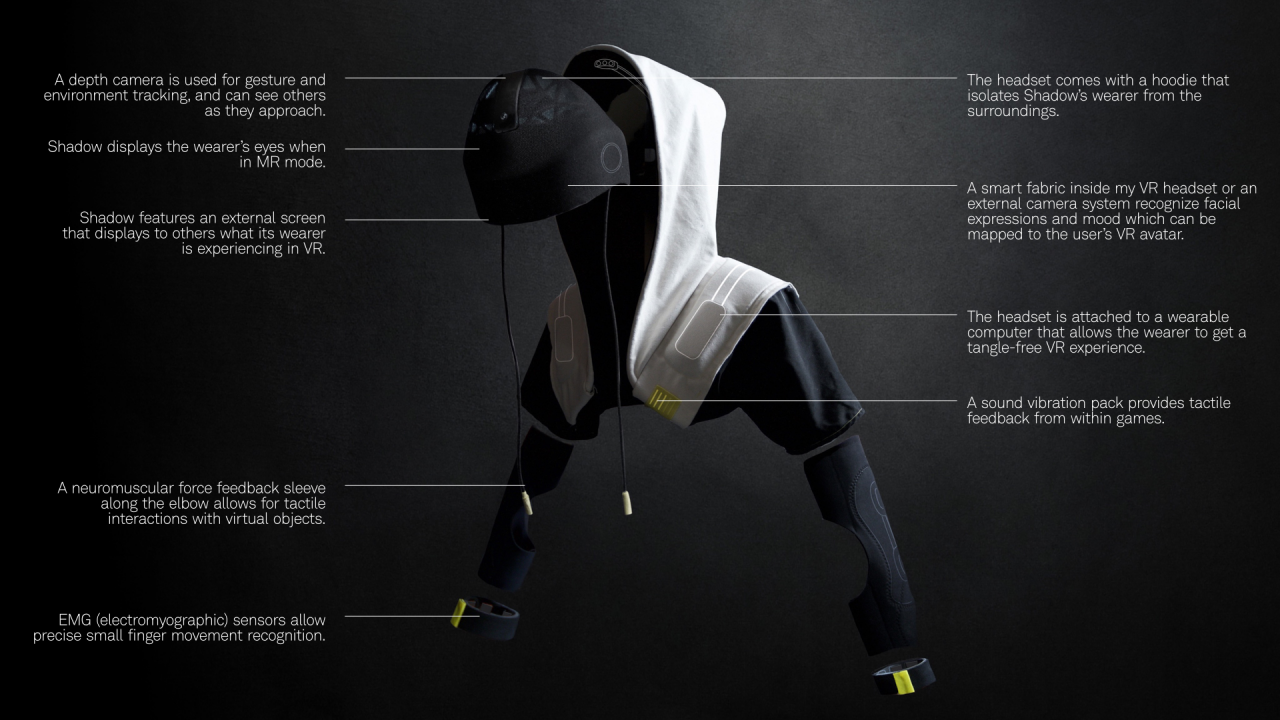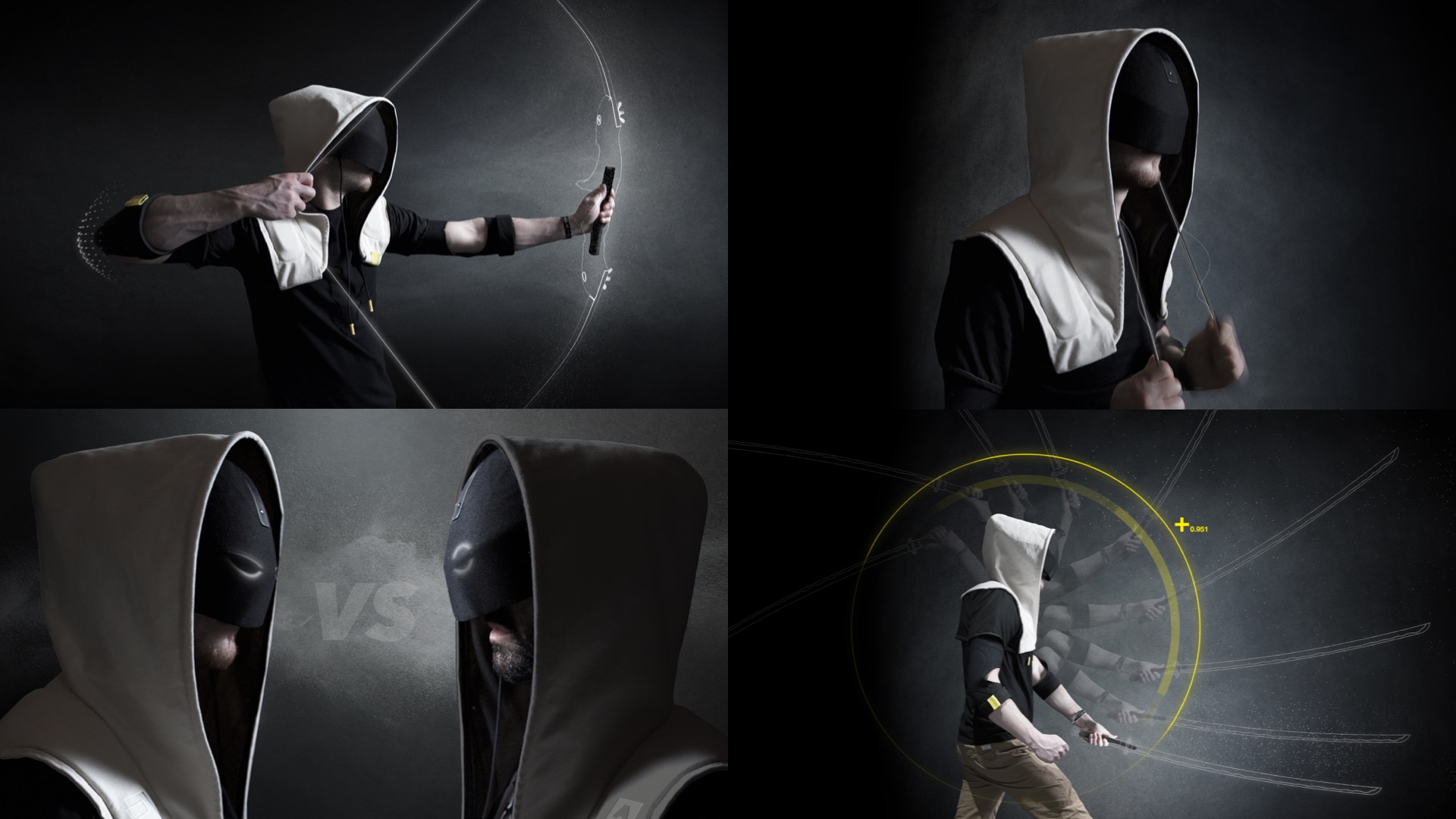VR headset concepts focus on immersion and inclusion
Artefact Group believe VR experiences can be adaptive to any situation and cover a range of more or less inclusive or immersive experiences, so they set out and devised a concept hardware experience feasible for VR in 2020. The two resulting concepts—nicknamed Light and Shadow—paint a portrait of virtual reality that looks like anything but science fiction. The project is a series of wearables for gamers who want the most immersive VR experience and interact with others mainly in the virtual space.
The computer and battery are built into the hood and shoulder cloak, untethering the user from cables. Going beyond just sight, ‘Shadow’ incorporates hearing and touch through sensors in the arms, hands and body to bring the experience to a new level of immersion.
A separate headset called ‘Light’ is for groups of friends who want to experience VR together. Simple and sharable, it allows the user to stay connected not only to the virtual world but to the people and environment around them.
A front facing camera allows users to see their surroundings, while a sharable mode shows others the content they are experiencing. Sound is delivered through adjusting a bone conduction system that still allows for ambient sounds to travel.

Markus Wierzoch, the lead designer on the project, explains that VR’s biggest asset is, paradoxically, its biggest shortcoming. Its immersion allows us to enter new worlds. But that immersion comes at the cost of inclusion—the people around us can’t join in our experience. VR is inherently asocial.
"There’s a series of selfies taken with a person wearing a VR headset, and the person with the headset never looks very good," Wierzoch says. So the studio generated alternatives. One headset would prioritise immersion. It would be a privacy-focused hoodie called Shadow. Another headset would prioritise inclusion; it would be a minimal fabric band called Light.
"That makes sense especially in a parent-child VR relationship," Wierzoch says. "As a parent, you could easily glance at what it is your kid is looking at."
However, this external display isn’t built for gawking. In fact, it’s dimmed by a layer of fabric, so it’s less distracting than it is referential. If someone in the room would like to join into your experience, they can pull out their smartphone to share a direct feed.
And on the other hand, if the VR wearer would like to see the real world, they simply pinch near their eyes to turn the virtual world translucent. (In fact, the HTC Vive has a similar safety feature if you walk too closely to a wall.)
The second concept, Shadow, is built more for a person seeking immersion—the deepest, most tactile experience possible in VR. You’ll notice that it doesn’t look like your average VR headset. Instead, it’s essentially a hoodie, because if you think about it, a hoodie is a garment that already has personal privacy settings built in.
"This gesture of pulling the hood over your head signals that now I’m in my space," Wierzoch says. "We felt that was very powerful, not only visually, but in terms of the user experience it yields."

Inside the hood, light is naturally blocked, and integrated hardware can track eye and facial movements. These expressions can be conveyed on the face of an online avatar, but they also might be conveyed to other people in your actual room. If you close your game to look around the room instead, the hoodie might show two glowing eyes.
Meanwhile, the hoodie includes a backpack with a small computer, front batteries sewn into the fabric, rumbling audio that can hit you like the purr of an engine passing by, and sleeves that can stiffen to restrict your movements.
And in what may be the biggest technological stretch for their five-year time frame, the designers even suggest that wristbands might read the electrical impulses through your arms so that they can detect the gestures you make with your hands.
Both concepts are untethered from some mini tower PC, to allow free movement. Each makes particular use of textiles, in contrast to the plasticky Beats by Dre aesthetic of modern wearables. And even though Shadow is technically designed for a single user, the two concepts still acknowledge the one thing VR currently forgets: that there are other people in our lives, sitting there, and often wanting to talk, even as we pretend to be somewhere else.







